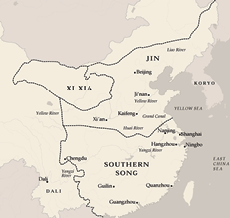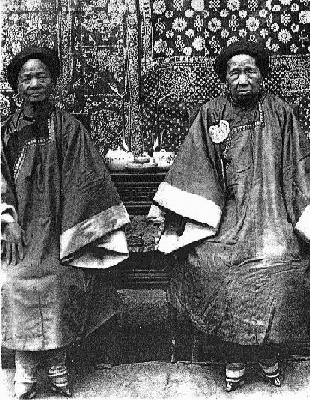
Hist 487_8: The subordination of women
Summing up Bray
Subordination in labor division and education
The ancient proverb 'men till, women weave' which since the 5th cent. BCE. had described the labor division within the household -men producing the grain to support the family as well as the tax grain, women weaving the cloth needed by the members of the household as well as tax cloth- becomes invalid by the end of the Song dynasty.
Growth the urban population increased the demand of
simple tabby weaves as well as complicated silk fabrics:
- Because urban residents with professions not related to textile production
bought tabby to pay their taxes.
- Because in the Southern Song private manufactures with hired weavers were
set up to meet the demand of fabrics with complicated weaving patterns. Women
were excluded from participation in this job competition because they could
not advertise their expertise on the job market.
- With tax increases it became difficult for the average household to produce
a surplus of cloth; women were pre-occupied with meeting the required tax quota
and the amounts of cloth needed for everyday use by their families.
Textile production had been part of the prescriptions for women as described by the female historian Ban Zhao in the Han dynasty who had promoted four demands women were supposed to meet:
Womanly work, womanly virtue, womanly speech, womanly
conduct.
Womanly work referred to all tasks related to cloth production which was considered
to make women persons of virtue, because they learned to respect the work of
others, and were trained to become frugal, diligent, self-disciplined &
orderly persons.
Their work was tied to the social value of cloth:
- cloth was used as tax payment, gift, marriage capital,
trousseau.
- cloth was a sign of mourning (coarse untrimmed hemp); ramie; cotton
The significance of cloth production can be demonstrated by the multi-level meaning of the character jing: the originl meaning is warpthread; the same character is used for the central, ritually important north-south axis of a city, for the meridians used as acupuncture tracts which keep the vital force (qi) circulating within the body, and for the Classics, the canonical books of Confucian education.
Until the Song cloth had been produced in peasant households (family labor), large elite households (family labor, supported by servants and hired female workers), and state manufactues with up to 400 looms (permanent or temporary or conscripted workers). In the Song urban workshops were created that helped to propell consumption. Until the Song sumptuary laws that regulated color, weaving patterns, and cut of fabrics for clothing which in the north consisted predominantly of silk and hemp, in the south of ramie and bast-fibres that require splicing. During the Southern Song, when large sericultural production areas had been lost to the Jin, silk production moved to the south.
Lady Huang Sheng's tomb is an indicator for luxury fabric consumption by members of the scholarly upper class. Lady Huang had been the wife of an official in the civil service and was given 345 pieces of fabric to support her in the supernatural realm. 201 pieces of clothing, 56% of which were made of seemingly modest gauze which consisted of highly complicated bindings and patterns. Complex weaves like damask, satin, brocade, and gauze with intricate patterns in modest colors were en vogue in Song urban fashion. They were produced by hired men and few women (belonging to the households of manufacture owners) working in private enterprises. Though women had been involved in the technological improvements of weaving technology on all stages (they developed and improved the spindle wheel - to be able to spin several threads simultaneously- and the treadle operated loom; Xu Wenmei, wife of the official Qin Guan (1049-1100) had written the essential manual on sericulture; Huang Daopo from Huainan Island had introduced the equipment and technique for ginning, bowing, and spinning of cotton) their participation became reduced to that of the producers of yarn while men took over the domain of professional weaving.
Some numbers: production time:
1 bolt of silk 8-16 days (depending on grade of complexity of the fabric)
1 bolt of bast-fibre cloth: 2 days
1 bolt of cotton: 1-2 days with four days of spinning material equalling 1 day's
weaving material (often causing a loss for the women if they sold the cotton
thread they had produced but had to buy ready made clothes!).

Subordination by footbinding
Footbinding developed from a fashion prominent among courtesans to a tradition promoted by orthodox conservatives. The invented tradition was later associated with womanly virtue because it was eventuallly followed among all families who could afford to keep their daughters confined within the home most of their lifetime.
[Further information will be provided by Laura in her presentation].


Li Qingzhao (1084-ca. 1151)
A significant exception from the standard education and the process of subordination of women was the poetess Li Qingzhao (1084-c. 1151). Together with her husband, Zhao Mingcheng (1081-1129), she studied epigraphy and collected antiquities, books, paintings and other artifacts. They compiled a catalogue of two thousand ancient documents which she concluded with a postface that decribes the fate of their own collection. [Further to be explored by Megan.]